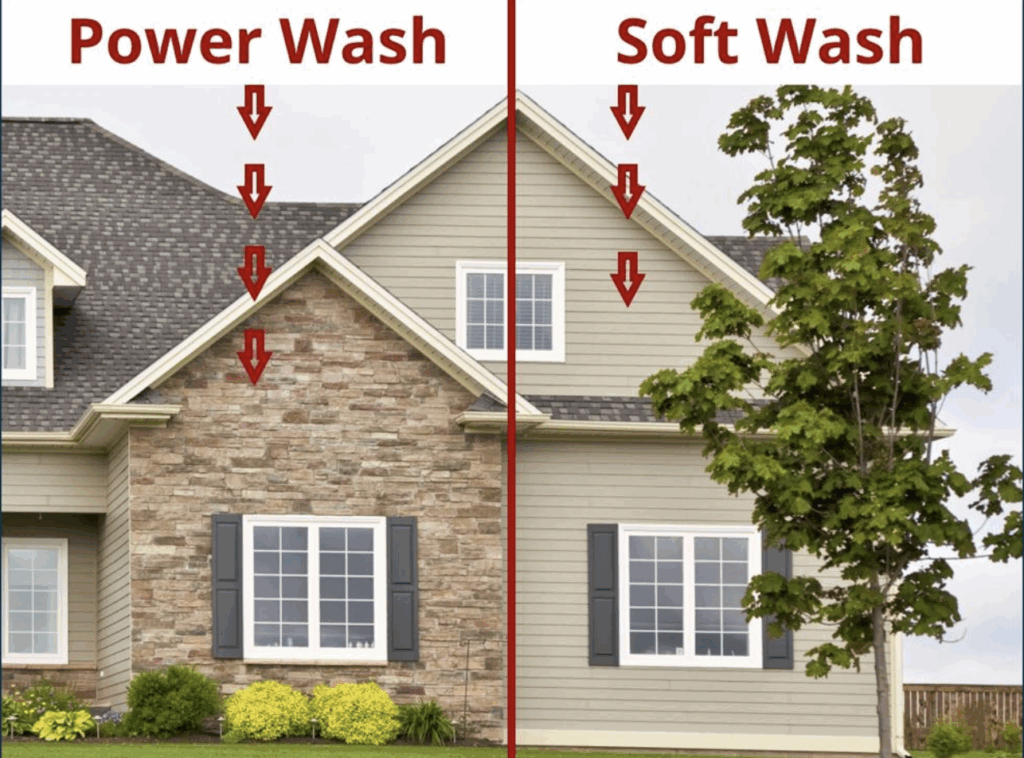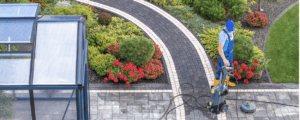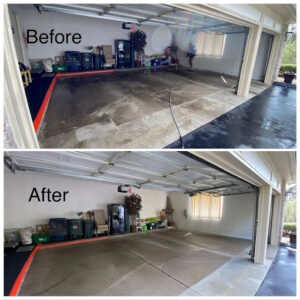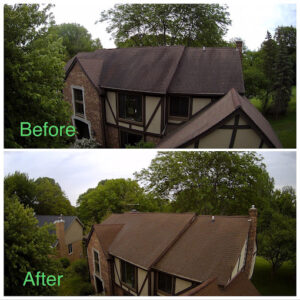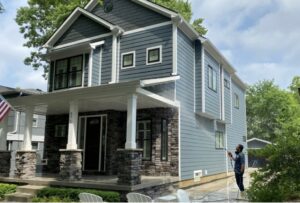Keeping Your Home Exterior Clean Matters
Your home’s exterior is constantly exposed to dirt, mold, algae, and pollutants. Over time, this buildup not only harms curb appeal but can also damage siding, roofing, and other surfaces.
When it’s time for exterior cleaning, homeowners often ask:
Should I choose soft washing or power washing?
While both methods restore your home’s beauty, they’re very different in technique, safety, and results. Choosing the wrong method can cause costly damage, so let’s dive deep into the comparison.
✅ What Is Power Washing?
Power washing (often called pressure washing) uses high-pressure water spray—typically 1,500 to 3,000 PSI—to blast away dirt, grime, and stains.
Best for:
- Driveways & sidewalks
- Concrete patios
- Brick, stone, and hardscape surfaces
- Parking lots & commercial exteriors
Why it works:
It uses sheer force to clean hard surfaces that can handle high pressure. It’s ideal for removing oil stains, chewing gum, mildew, and deep dirt embedded in porous concrete.
When NOT to use it:
On delicate surfaces like siding, roof shingles, or painted wood—it can cause cracking, chipping, or water damage.
✅ What Is Soft Washing?
Soft washing uses low-pressure water combined with eco-friendly cleaning solutions to safely remove algae, mold, mildew, and dirt.
Best for:
- Roof shingles (asphalt, tile, metal)
- Vinyl or painted siding
- Stucco, wood, or other delicate surfaces
- Outdoor furniture, screens, and gutters
Why it works:
Instead of relying on brute force, soft washing uses special detergents that kill organic growth at the root, preventing it from coming back as quickly.
When NOT to use it:
On heavily stained concrete or surfaces needing intense stain removal, power washing is more effective.
🔍 Soft Washing vs. Power Washing: Key Differences
Feature | Soft Washing | Power Washing |
Pressure Level | Low (safe for delicate surfaces) | High (1,500–3,000 PSI) |
Cleaning Method | Detergents + low water pressure | High-pressure water force |
Best For | Roofs, siding, wood, painted surfaces | Driveways, patios, concrete, bricks |
Prevents Regrowth? | ✅ Yes, kills algae/mold spores | ❌ No, only removes surface growth |
Risk of Damage | Minimal if done professionally | Higher if misused |
Longevity of Results | Longer-lasting clean | May need cleaning sooner |
✅ Which Method Should You Choose?
- Use Soft Washing If…
- You’re cleaning siding, roofs, or delicate surfaces.
- You want a longer-lasting clean that kills algae & mold.
- You prefer an eco-friendly cleaning approach.
- Use Power Washing If…
- You’re cleaning durable surfaces like driveways, sidewalks, or bricks.
- You need heavy stain removal (oil, rust, gum).
- You’re preparing surfaces for painting or sealing.
In many cases, a combination of both methods is best. For example:
- Soft wash the siding & roof
- Power wash the driveway & patio
✅ Why Hire a Professional Instead of DIY?
While renting a pressure washer may seem easy, improper use can strip paint, damage siding, and even void warranties on your roof or home exterior.
Professional exterior cleaning companies like Blue Bubble Cleaning Services:
- Know the correct PSI for each surface.
- Use specialized eco-safe detergents.
- Protect your landscaping, pets, and windows.
Deliver better, longer-lasting results.
🧼 Protect & Preserve Your Home the Right Way
Both soft washing and power washing have their place—but knowing when to use each is key to protecting your investment.
At Blue Bubble Cleaning Services, we assess your property and choose the safest and most effective method for every surface, ensuring a damage-free, long-lasting clean.
💬 Not sure which cleaning method your home needs?
📞 Contact us today for a FREE, fast quote and expert advice!

